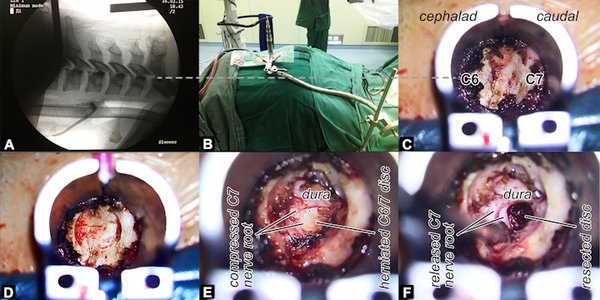-
Home
-
About JCTR
-
Gold Open Access
-
Issues
-
Editorial board
-
Author guidelines
-
Publication fees
-
Online first
-
Special issues
-
News
-
Publication ethics
-
Partners
-
Submit your manuscript
-
Submit your review report
-
Editorial Office
-

This work is licensed under a Creative Commons Attribution-NonCommercial 4.0 International License. ISSN print: 2382-6533 ISSN online: 2424-810X
Volume 9 Issue 4
Does the endoscopic keyhole technique have advantages over the microscopic keyhole technique for treating cervical radiculopathy?
Shutong Xu, Junlong Zhong, Zhenhai Zhou, Hao Lv, Jiachao Xiong, Shengbiao Ma, Zhimin Pan, Yong Zhang, Kai Cao*
Xu et al. J Clin Transl 2023; 9(4):23-00023
Published online: July 28, 2023
Abstract
Background: Both endoscopic keyhole and microscopic keyhole techniques are considered minimally invasive approaches. However, it is still unclear which is superior in treating cervical radiculopathy.
Aim: This study aimed to compare the clinical outcomes of the two methods for cervical radiculopathy.
Methods: Seventy-one patients with cervical radiculopathy caused by single-level disc herniation were retrospectively reviewed. These patients were treated with the endoscopic keyhole technique (EKT) (34 cases, classified as EKT group) or the microscopic keyhole technique (37 cases, classified as MKT group). Magnetic resonance imaging (MRI), neck disability index (NDI), and visual analog scores (VAS) were employed to assess clinical outcomes. All patients were followed up for at least 24 months.
Results: The average operative time (71.0 ± 15.2 min vs. 63.7 ± 18.9 min, p=0.131), blood loss (56.1 ± 18.2 ml vs. 64.4±13.5 ml, p=0.068), and hospital stay (24.9 ± 5.6h vs. 28.3 ± 7.1 h, p = 0.061) between the EKT and MKT groups were not significantly different. Postoperative MRI demonstrated that effective neural decompression was obtained in all cases after surgery. The NDI in both groups was significantly decreased from pre- to postoperatively (EKT group: 32.8±9.4 vs. 9.2 ± 3.6, p < 0.001; MKT group: 36.2 ± 11.3 vs. 10.5 ± 4.1, p < 0.001), VAS (EKT group: 5.6 ± 2.3 vs. 1. 5± 1.0, p < 0.001; MKT group: 6.2 ± 2.1 vs. 1.9 ± 0.8, p < 0.001). Nine patients in the EKT group underwent revision surgery due to recurrent disc herniation compared with 2 patients in the MKT group (p=0.034). The interval time from primary surgery to revisional surgery was shorter in the EKT group than in the MKT group (21 ± 5.8 w vs. 29 ± 7.2 w, p < 0.001). There were 2 patients with temporary nerve root irritation and 1 patient with cerebrospinal fluid leak that occurred in the EKT group versus 1 patient who suffered nerve root irritation in the MKT group (p = 0.547).
Conclusions: Both EKT keyhole and microscopic keyhole techniques are effective in treating cervical radiculopathy. However, compared with the microscopic keyhole technique, the endoscopic keyhole technique brings about a higher revision surgery rate with a shorter interval time from index surgery to revision surgery.
Relevance for patients: These findings suggest that the microscopic keyhole technique seems to be a better way of treating cervical radiculopathy.

DOI: http://dx.doi.org/10.18053/jctres.09.202304.23-00023
Author affiliation
1. The Orthopedic Hospital, The First Affiliated Hospital of Nanchang University, Nanchang 330006, China
2. Pain Department, The First Affiliated Hospital of Nanchang University, Nanchang 330006, China
*Corresponding author:
Kai Cao
The Orthopedic Hospital, The First Affiliated Hospital of Nanchang University, Nanchang, Jiangxi Province, 330209, China.
E-mail: kaichaw@126.com
Handling editor:
Michal Heger
Department of Pharmaceutics, Utrecht University, the Netherlands
Department of Chemistry, Utrecht University, Utrecht, the Netherlands
Department of Pathology, Erasmus Medical Center, the Netherlands
Department of Pharmaceutics, Jiaxing University Medical College, Zhejiang, China

